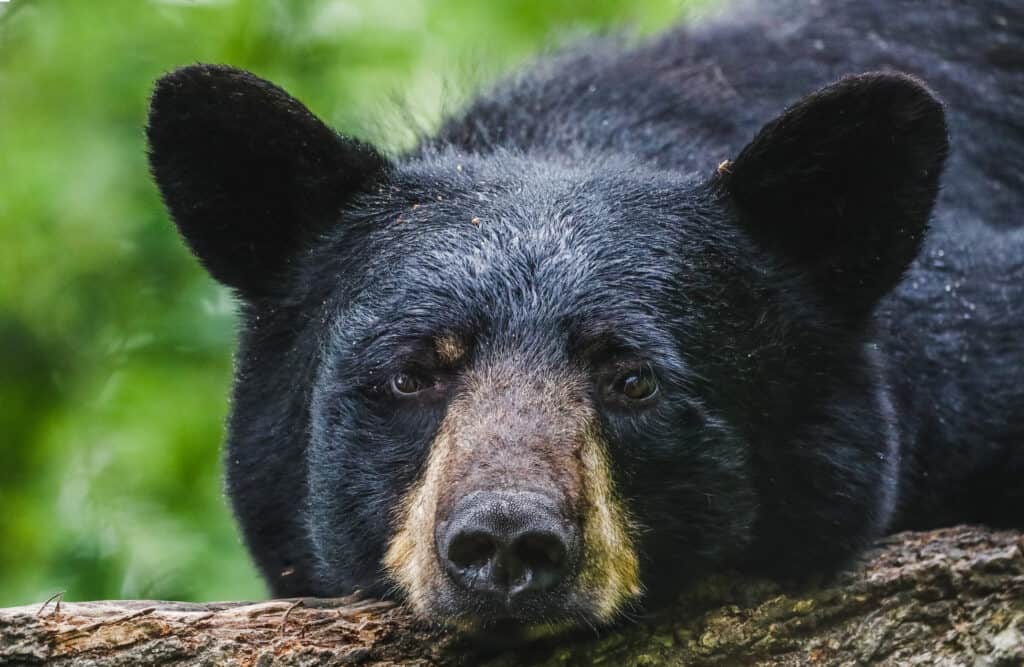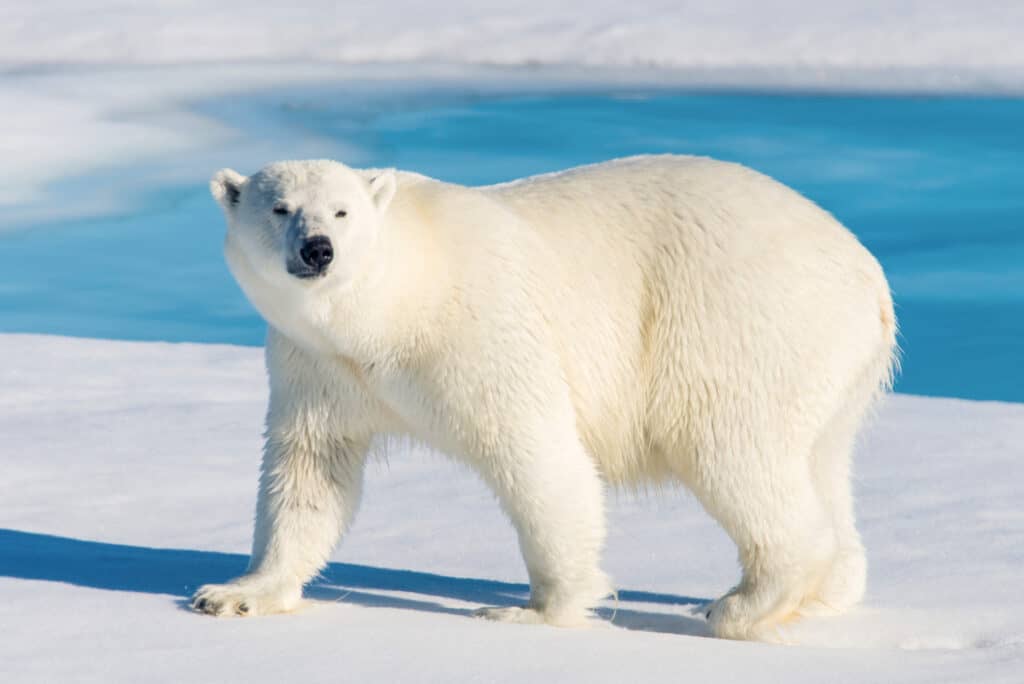There are three species of bears in North America: black bears, brown bears, and polar bears.
- Black bears inhabit 40 of the 50 United States.
- Brown bears only live in the United States in Wyoming, Montana, Idaho, and Washington. The population of brown bears in North America is 55,000
- Polar bears inhabit only one state, Alaska. The population of polar bears worldwide is 31,000, and 7,000 live in Alaska.
American Black Bear (Ursus americanus)
American Black Bear is the bear with the biggest population in North America. They can adapt to living in forests, beaches, or mountaintops. Black bears are great scavengers and eat just about anything they can find. They have curved claws, which are great for climbing up trees to get food; they are also pretty good at digging. Black bears are smart animals and know how to get food from campsites, garbage cans, and inside cabins. If there are berries or nuts available, bears will eat as many as they can to fatten up for winter. They also eat insects, plant roots, salmon, birds, eggs, and rodents.
Black bears spend their winters inside a den, nice and warm. They will make a den out of an old stump, rock crevice, or the large root ball of a fallen tree. They hibernate for nearly six months in very cold areas. During hibernation, all of their bodily functions slow down, so they don’t have to drink water, eat food, or expel waste. Pregnant bears will give birth in the den over winter and emerge in the spring with new cubs!
Black bears do not stay in packs and prefer to live alone, except during mating season. Mating happens in the warm summer months, and babies are born in January and February. Bear cubs are born hairless and weigh less than half a pound! A female black bear can have one, two, or even three cubs at once. By the time the cubs are one year old, they weigh around 80 pounds. They stay with their mother for one and a half years.

Black bears are smart animals and know how to get food from campsites, garbage cans, and inside cabins.
©iStock.com/Mandy Fuller Photography
Brown Bears (Ursus arctos)
Brown bears (also called grizzly bears) are between 3 and 5 feet tall at the shoulder and can get up to 7 feet in length. If a very large brown bear were to stand on its hind legs, it would be nearly 9 feet tall! Brown bears can weigh up to 1,000 pounds and live for 25 years. You can tell brown bears apart from other bears because of the large humpback. They can range in color from light brown to dark brown.
Brown bears like to eat a mixture of animal protein, berries, plants, fish, and small mammals. They are excellent diggers, the best of all the bears, because of their long-hooked claws. They are also very intelligent and know how to use their claws like tools to open car doors, climb into windows, and open food boxes. Brown bears eat a wide variety of animals, from large elk to tiny insects. They love pine nuts, blackberries, tubers, and dandelions. They munch on white bark pine seeds, herbs, beavers, salmon, and various types of grass. When preparing for winter, they need to eat up to 30 pounds of food per day! Some brown bears in Alaska eat 80 pounds of food in one day during the summer and fall and gain an amazing 6 pounds of fat daily.
Brown Bear Hibernation
Brown bears enter their dens for winter in October or November and sometimes as late as December if it is warm. They usually use their powerful claws to dig their own dens. Most grizzly bears will sleep all the way through winter, but a few in some of the warmer areas will remain active throughout the year. Pregnant bears give birth in the den and emerge with their cubs in April or May.
Just like black bears, brown bears are mostly solitary creatures. They are together during mating season or when crowded around a particularly delicious food source. Female brown bears start mating when they are five or six years old. Mating season is June and July, and females will try to mate with multiple partners during the season to ensure successful reproduction. Litters contain one, two, or three cubs, but a couple of quadruplets have been recorded. Brown bear cubs are hairless and weigh about half of one pound. They spend the winter nursing and weigh 5 pounds by spring. Brown bear babies stay with their mothers for a full two years to learn to hunt and forage.

When preparing for winter, grizzlies need to eat up to 30 pounds of food per day!
©Perpis/Shutterstock.com
Polar Bears (Ursus maritimus)
Polar bears are the largest bears in North America. The average polar bear is seven feet tall and weighs 1,200 pounds. The lifespan of a polar bear is 30 years.
Polar bears have learned to thrive in the harshest, coldest conditions. They have black skin to help absorb heat, white coats that repel moisture, and webbed paws to swim like a fish. In the United States, polar bears only live in Alaska, where the population is nearly 7,000.
Polar bears favor meat as their main dish. There aren’t many berries or green plants to munch on in arctic environments. Polar bears eat seals, whale carcasses, and rodents. They have been known to consume up to 100 pounds of seal blubber in one sitting!
Polar hibernation is different from that of the other bears on our list. Only pregnant female polar bears hibernate; they sleep in their dens until the babies are born and then wake up to care for and nurse the cubs. Polar bears give birth to between one and three cubs during the winter. Polar bear cubs are only a foot long when born and weigh barely one pound. The baby bears stay with their mothers for two years to learn how to survive in the frozen tundra.

Polar bears have learned to thrive in the harshest, coldest conditions.
©iStock.com/Alexey_Seafarer
14 Fun Facts About Bears
- Not all black bears are black. Some of them are blonde, blueish-gray, white, red, or even cinnamon in color! Some black bears living on the coast of British Columbia are white.
- Black bears like to swim. They can swim across a river or lake with no problem.
- Brown bears have long curved claws and are the best diggers.
- Polar bears are the largest bears in the United States.
- When they want to stretch out and rest after a huge dinner, bears will dig a hole in the ground for their big full belly to rest!
- Brown bears are most active at dusk and dawn.
- A few brown bears have been born cream-colored or black rather than brown.
- During hibernation, a bear’s heart goes down to only 10 beats per minute.
- Black bears are expert tree climbers. They don’t only climb trees; they run up trees.
- Black bears can run up to 30 miles per hour.
- Black bears can smell food up to one mile away.
- Polar bears travel a long distance to find food, sometimes up to 1,800 miles in one month.
- Polar bears are one pound when born and grow to 30 pounds in the first two months of life. Polar bear milk contains 31 percent fat to help babies grow quickly.
- Polar bears have non-skid paw pads to help them grip the ice. It also helps that their paws are the size of a 12-inch pizza!
Summary of Bears in North America
- Brown Bears (Ursus arctos)
- Black Bears (Ursus americanus)
- Polar Bears (Ursus maritimus)
NEXT UP:
The photo featured at the top of this post is © elena_prosvirova/Shutterstock.com
Thank you for reading! Have some feedback for us? Contact the AZ Animals editorial team.







